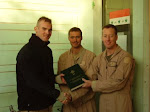 Eructávit cor meum verbum bonum: * dico ego ópera mea Regi
Eructávit cor meum verbum bonum: * dico ego ópera mea RegiLingua mea cálamus scribæ: * velóciter scribéntis.
Speciósus forma præ fíliis hóminum, diffúsa est grátia in lábiis tuis: * proptérea benedíxit te Deus in ætérnum.
Accíngere gládio tuo super femur tuum, * potentíssime.
Spécie tua et pulchritúdine tua: * inténde, próspere procéde, et regna.
Propter veritátem, et mansuetúdinem, et justítiam: * et dedúcet te mirabíliter déxtera tua.
Sagíttæ tuæ acútæ, pópuli sub te cadent: * in corde inimicórum Regis.
Sedes tua, Deus, in sæculum sæculi: * virga directiónis virga regni tui.
Dilexísti justítiam, et odísti iniquitátem: * proptérea unxit te, Deus, Deus tuus, óleo lætítiæ præ consórtibus tuis.
Myrrha, et gutta, et cásia a vestiméntis tuis, a dómibus ebúrneis: * ex quibus delectavérunt te fíliæ regum in honóre tuo.
Ástitit regína a dextris tuis in vestítu deauráto: * circúmdata varietáte.
-- Psalmus 44(1-10), Feria quart ad Matutinum, Breviarium Romanum
(Photo: On the Monday of Holy Week the Abruzzo region of Central Italy was hit by its most devastating earthquake in 30 years, measuring a magnitude of 6.3 and claiming almost 300 lives. Amidst the wreckage, however, there emerged a sign of hope.
It happened in Rocca di Cambio, the highest mountain village in the Gran Sasso Mountains of Abruzzo. There, in the church of San Pietro alla Collegiata, a fresco of the Virgin Mother and infant Jesus was discovered.
The fresco appeared when the earthquake shook the church and the altar came away from the wall. Experts believe the artwork is from the 11th Century at the time the church was built. More on the story here.)
It happened in Rocca di Cambio, the highest mountain village in the Gran Sasso Mountains of Abruzzo. There, in the church of San Pietro alla Collegiata, a fresco of the Virgin Mother and infant Jesus was discovered.
The fresco appeared when the earthquake shook the church and the altar came away from the wall. Experts believe the artwork is from the 11th Century at the time the church was built. More on the story here.)









